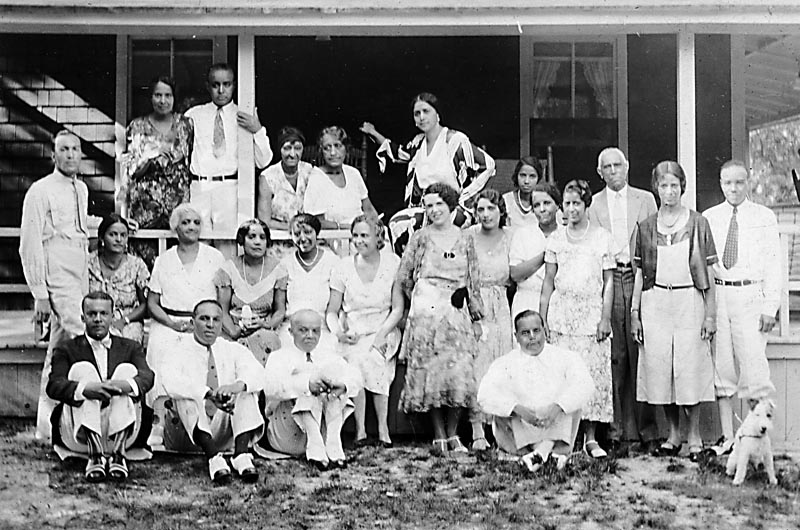A rich history familiar to Vineyarders will soon reach a national audience.
Oak Bluffs is one of 10 communities included in a national exhibit planned to inaugurate the The National Museum of African American History and Culture, set to open on the Washington Mall in late 2015.
The town, a treasured summer community among middle and upper class African Americans for more than a century, will help tell a larger, underrepresented history of black leisure, Smithsonian curators said this week.
“There are certain ways that African American history gets portrayed, and showing the life on Martha’s Vineyard allows us to picture a life through a different prism,” said curator Dr. Paul Gardullo in a telephone interview. “It gives them a new look at a culture they think they may know.”
The show, Places of Pride, will replicate two cottage porch scenes, and incorporate artifacts and local knowledge from the Oak Bluffs community.
The Island’s first black-owned inn, Shearer Cottage, will feature prominently alongside the Powell Cottage, owned by the late Adam Clayton Powell Jr.
Mr. Gardullo’s colleague, Kevin Strait, already knew the Island well before he began his research. His father has a home in West Tisbury, and his mother, a home in Oak Bluffs.
But this project opened his eyes to a richer history than even he, a historian, was aware of.
“Little did I know so much history existed in the backyard of our summer home,” he said.
The exhibit will speak to those already familiar with the town’s black history, as well as those who have no knowledge of the Island or Oak Bluffs.
“We are really going to focus on questions related to regional identity and black leisure in the era of segregation,” Mr. Gardullo said.
The Smithsonian began collecting artifacts and information about the Island’s African American history a few years ago, and will continue to shape the exhibit in advance of the museum’s opening.
They came to the Island on a few occasions, meeting with several local historians, including Elaine Weintraub, board chairman of the African American Heritage Trail, and Robert Hayden, president of the Martha’s Vineyard branch of the Association for the Study of African American Life and History.
Islanders helped to shape their vision, and broaden the perspective of the exhibit, from a focus on vacation to a larger narrative of black success, and multi-generational Oak Bluffs home ownership, Mrs. Weintraub said.
“I think that Oak Bluffs is enriched by the African American community on so many different levels, and I think its inclusion is absolutely essential to any exhibition,” she said.
Gretchen Tucker-Underwood, who spent many summers with her aunt in town and now lives in the family home full time, said many assume that the vacationing on the Island was only for the wealthy.
“I think too many people don’t understand the magic of the Vineyard, especially talking about the Bluffs,” she said.
In the 1950s and 1960s, kids entertained themselves bike riding, and watching coin diving near the ferry dock.
“There were a group of 10 or 12 young, rather handsome boys who would swim out to the Oak Bluffs ferry and request coins,” she recalled. Then these “fine specimens of lads” would dive down to retrieve them, she said.
Mr. Gardullo said that while the Smithsonian is often thought of as the keeper of historical knowledge, they often cede to local sources.
“In a place like Martha’s Vineyard, where there is such a rich sense of history and pride and heritage, we don’t want to assume that we know the story,” he said.
Cookbook author and historian Jessica Harris, part-time Oak Bluffs resident, donated an old lawnmower and a kerosene lamp from her family cottage, which dates to the 1870s. She hosted the curators and several longstanding members of the African American community in her home, including Olive Tomlinson, who shared photographs taken by her father of productions put on by the Shearer Summer Theatre with the museum.
“All of them were amateur thespians, and my father was the amateur photographer,” Ms. Tomlinson recalled. “He took black and whites and developed them himself in the closet.”
He would have been proud to know his photographs were being studied by historians, she said. “When I give the pictures, it is really for my father,” she said.
As a whole, the exhibit seeks to demonstrate the richness and diversity of African American culture through the lens of region and culture, Mr. Gardullo said. “We knew we wanted to tell it through intimate stories that rooted visitors in particular places, across the north, south, east and western regions,” he said. “Oak Bluffs rose to the top of a very short list of places.”
The other sites under consideration include Tulsa, the Black West, the rice fields of South Carolina, Chicago, the Bronx, Greenville, Miss., and a hat shop in Philadelphia.
Visit nmaahc.si.edu for more information.








Comments (29)
Comments
Comment policy »